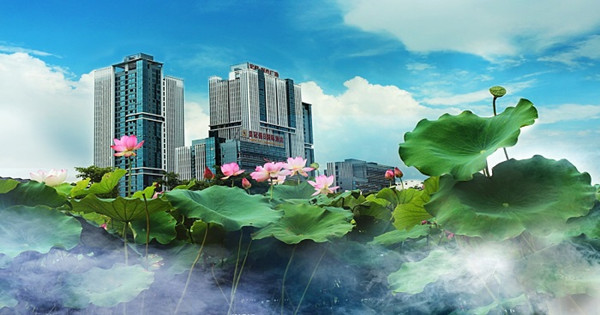Guigang
Guigang is located in the southeast of Guangxi and the middle reaches of the Xijiang River in the Pearl River Basin. It has jurisdiction over Guiping City, Pingnan County, Gangbei District, Gangnan District and Tantang District. Guigang covers a total area of 10,602 square kilometers, of which the downtown area is 53 square kilometers. Its total population is 5.55 million and the population density is about 522 per square kilometer. Guigang has a long history of planting lotuses, and it is known as "Lotus City".
Guigang is a new city with profound history. The famous historical and cultural relics in the city include Bushan Cultural Relics, Luobowan Han Dynasty Tombs, Nanshan Temple, Xishan Mountain, Baishi Mountain, the Jintian Uprising site and the site of the first National Congress of the Communist Party of China in Guangxi.

Guigang is known as "Lotus City". [Photo/gxgg.gov.cn]
Guigang is a dynamic emerging inland port city, and one of the starting cities of the Maritime Silk Road. It is also a strategic node of the Pearl River-Xijiang Economic Belt. The city has unique location advantages. Guigang Port is one of the major inland river ports in China. The port's annual cargo handling capacity, annual shipbuilding capacity and annual cargo shipping capacity account for more than half of those of Guangxi. It is the most mechanized inland river port in Guangxi and the most convenient southeastern maritime passage in China.
Guigang is a traditional agricultural city. It has an area of 361,500 hectares of cultivated land, 18.7 percent of the total cultivated land in Guangxi. The cultivated land area per capita is 1.06 mu (0.07 hectares). Known as the "land of fish and rice", Guigang is an important production base for commercial grain, sugar, fruit and poultry in Guangxi. The city has four autonomous-level agricultural demonstration areas including the Tantang Lotus Root Industry (Core) Demonstration Zone, the Yaji Mountain Ecological Aquaculture (Core) Demonstration Zone, the Four Seasons Huatian Leisure Agriculture (Core) Demonstration Zone, and the Guiping Food Industry (Core) Demonstration Zone.
Guigang is an emerging industrial city. The city has large cement production enterprises such as China Resources (Guigang) Cement and China Resources (Pingnan South). Cement production in Guigang accounts for about a quarter of that of Guangxi's. A number of enterprises in Guigang such as Guangxi Guigang Iron & Steel Group Co Ltd and Guangxi Guitang (Group) Co Ltd are among the top 100 enterprises in Guangxi. There are more than 2,700 forest product processing enterprises in the city, with an output value of nearly 30 billion yuan ($4.36 billion). Its plywood production accounts for 60 percent of that of Guangxi, and its plate exports account for 50 percent of that of Guangxi. Guigang is an important plywood, veneer production and processing base and forest product distribution center in China. In recent years, it has focused on strategic emerging industries, and has introduced the development of new energy vehicles and the electric vehicle industry, the electronic information technology industry and the bio-pharmaceutical industry. Guigang is entering the new era of "Made in Guigang".
Guigang also has rich resources. The city has the first supercritical million kilowatt-class thermal power plant in Guangxi. There are more than 40 kinds of mineral resources with development value; its reserves of aluminum are more than 220 million tons, ranking the top in the country. The city's forest coverage rate reaches 46.3 percent. In recent years, Guigang has won the "National Double Support Model City" title eight times and the autonomous region level "Double Support Model City" title nine times. Guigang was nominated for the national civilized city award. It is also a health city and garden city of Guangxi. Guigang is an important tourist destination in Guangxi and a key historical and cultural tourism center in southeastern Guangxi. It has five national-level scenic spots, including the Guiping Xishan Scenic Area, and 13 autonomous region-level scenic spots such as Donghu Lake and Nanshan Scenic Area, as well as a Datengxia Ecological Tourism Zone and other ecological tourist destinations.


